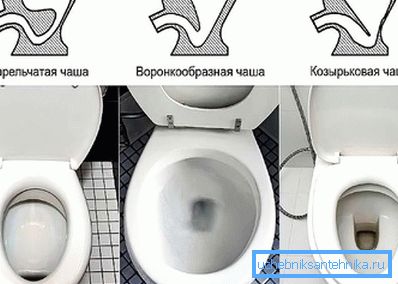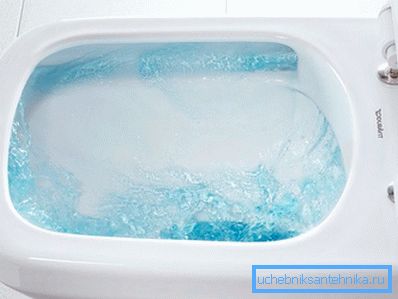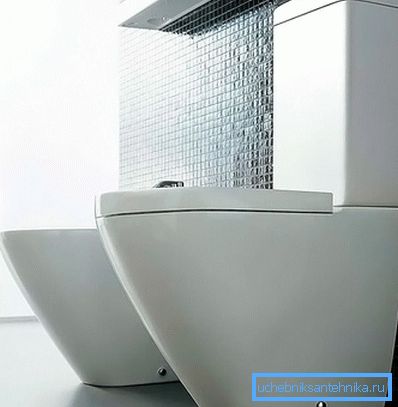How to choose a toilet
Before you make this or that purchase, each person tries to make a thorough comparison of the goods in order to choose the best one. The toilet belongs to the category of plumbing, which deserves special attention. In order to choose a good toilet, you need to consider the following important points: the shape, color, size and material used for manufacturing. The article will discuss how to choose the toilet correctly without splashing, provide an overview of popular companies.
Shape selection

Properly chosen form of toilet bowl is a very important aspect, since otherwise far from non-sterile drops can get into the most sensitive area of the body.
Depending on the shape, there are 3 types of toilet bowls:
- Disc. Toilets of this form are available in the range of both imported and domestic manufacturers.
- Funnel-shaped. The internal structure of such a toilet bowl looks like a funnel, which he deserved for himself that name. The main advantages are: low water consumption, blocking unpleasant odors, cleanliness (the walls do not hold up either a solid or a liquid mass, therefore, you will have to use a brush very rarely). But, if the main goal is to eliminate splashes and splashes, then the acquisition of a funnel-shaped product is not advisable. This type of toilet bowl is classified as economical, which is why they are often installed in public places.
- Visor. The back and front walls of this toilet bowl have a slope of 30 to 45 degrees or the bowl itself is made in the form of a kind of "visor", which serves as an obstacle to the formation of splashes. The visor type of the toilet bowl is the most popular, as it is rarely necessary to do periodic disinfection, cleaning with a brush is practically not required, the smell from sewage pipes does not penetrate into the apartment, and no sprays are formed.
Product classification by drain method

Drain is circular or cascade. The circular type of drain is somewhat similar to a shower - several jets of water flow down the walls of the toilet and quickly clean the surface. A toilet with such a sink will cost a little more, but it will be much quieter, more efficient and more economical.
The classic cascade drain is made from a single hole, from which a stream of water flows around the bowl under pressure. The main advantages are the reasonable price and long service life of the toilet with this type of drain. Among the negative points worth noting is the high consumption of water and the need for frequent cleaning of the toilet bowl surface.
Hygiene, cost effectiveness and noiselessness are the characteristic properties of a toilet bowl equipped with a circular drain system. The high cost is fully justified by the number of advantages described above.
In addition, you need to pay attention to the diameter of the drain, because it depends on the long and efficient operation of the sanitary device.
Types of devices depending on the material used

Porcelain and earthenware are most often used for the manufacture of toilet bowls, but the use of artificial and natural stone, polished stainless steel, acrylic, gold, polymer concrete, glass and other materials has not been canceled. Types of toilet bowls, depending on the material used for their manufacture:
- Porcelain occupies a leading position, as it has excellent hygienic properties. It is characterized by fine porosity, therefore, the surface for a long time remains clean, in addition, it can be affected by caustic concentrated cleaning agents. Lifetime is long, the surface is aesthetic, and strength indicators will be quite enough for use at home.
- Faience is an inexpensive analogue of porcelain. It has a shorter service life than porcelain, and strong alkalis, acids and active mechanical cleaning with the use of any abrasive agent can damage its surface. The indicator of strength is medium, and quality is acceptable with careful use and maintenance of the toilet bowl.
- Polished stainless steel is the most common material to be installed at a place of public use (for example, a train). Steel is strong, durable and completely hygienic.
- Cast iron is a very economical material used for the manufacture of a toilet bowl. It is characterized by strength and durability, but its surface will always be cold, and the appearance is unattractive.
- Acrylic is cheap and easy to transport and install. But plastic can not be called durable and the more hygienic material. High temperatures (hot water will drain into the toilet), cleaning products and blows - all this cannot withstand an acrylic surface. But acrylic can be given the most intricate form, which is very surprising guests.

When choosing a toilet bowl, it is important to consider the technical characteristics of the material from which it is made. In addition, you should pay attention to the quality of the product and the choice of its shape. If you have any questions on the topic, then write comments to the article.
Video: how to choose a good toilet
In this video, detailed characteristics of different drain systems are given, the advantages and disadvantages of toilet bowls are described: